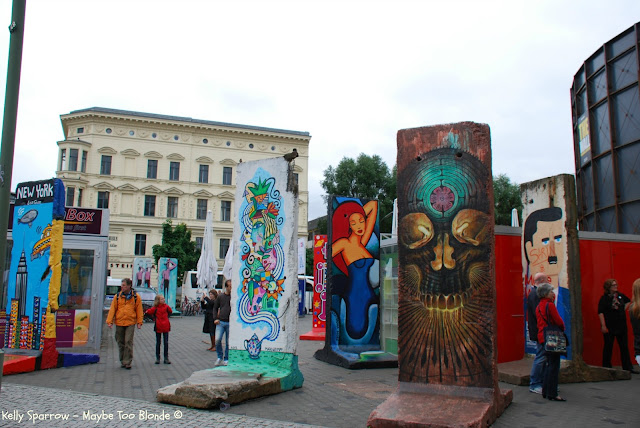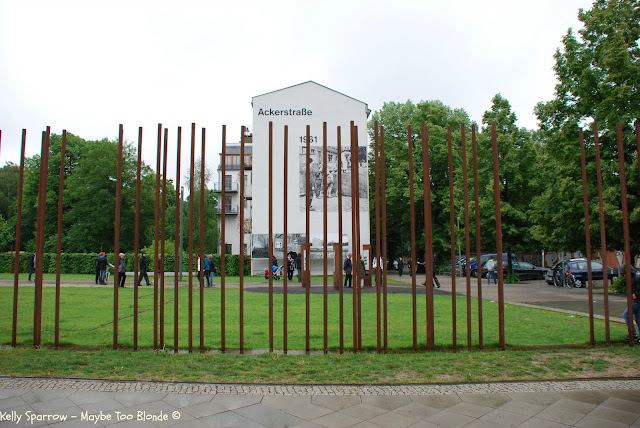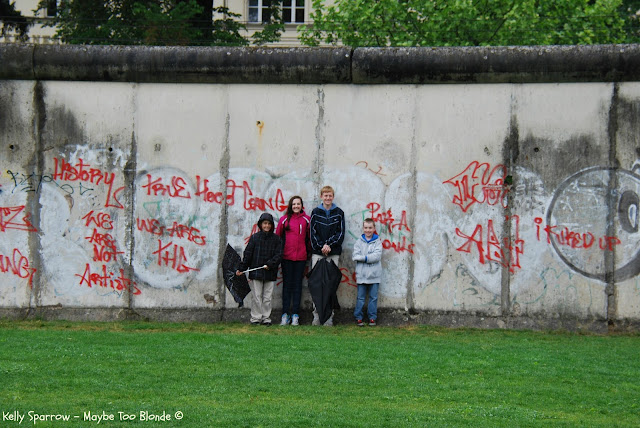Berlin trip continued -
The one thing that really sets Berlin apart from other large cities is its history with the wall, or Berliner Mauer in German.
The wall started to go up on August 13, 1961. It was constructed by the GDR, or East Germany, to stop the outflow of its citizens to West Berlin and then on to West Germany. Before the wall was erected, over 3 million East German citizens circumvented Eastern Bloc travel restrictions and fled to Western Europe. The East German government was scared that they would have no more people to boss around so almost overnight, the wall was put up.
If you go to Berlin today, there isn't much of the wall left. Just a few memorial sights where original pieces of the wall were left standing.
We started our tour of the wall at Checkpoint Charlie, a name given by the Americans. The other checkpoints were Alpha and Bravo. Here is a picture of a real American soldier (you will understand my emphasis on real soon) showing you that you are crossing into the American section, or from former East Berlin to West Berlin.
Here is the other side of the sign. A Soviet soldier letting you know you are leaving the American sector and crossing into the Soviet sector.
And here are the fake American soldiers standing there for tourists to get pictures with. I am going to rant a little here. If you don't want to read it, skip it.
Rant - Seeing this really pissed me off. In fact, the more I looked at it, the more pissed off I got. And pissed off isn't a phrase I use very often. These "American Soldiers" were nothing more than paid actors, which is fine, if they could even for a second resemble, even just a little bit, a real American soldier. Their uniforms were real, standard issue American Army uniforms. But they were wrinkled, and dirty, and mismatched. They weren't clean shaven. They had earrings in their ears. One had a huge beer belly. They were spitting on the ground. Maybe the reason this got my goat so much is I am married to an American soldier who has served his country for 23 years. He has been deployed three times to the Middle East. He takes pride in being an American (his parents were German and witnessed horrible things during the war and they moved to America to give their children a better life) and being a soldier. He stands for honor and integrity. I don't stand up behind the military or get all "hooah" very often, but I found it to be an absolute disgrace that the men and women of our Armed Forces were being represented by this mess. My son asked why I was getting so bugged and I answered, "Look at all these tourists here. Some of them probably think that these are real American soldiers. That isn't fair to actual soldiers who take pride in their uniform and appearance and the way the conduct themselves." Whew! Okay. Rant over. And please, I know that Americans, military and non-military alike, have embarrassed and looked horrible when they have traveled abroad. This just really got to me this day.
If you skipped the rant, start reading here -
Checkpoint Charlie was slightly interesting, but so congested with tourists, it was hard to read or look at anything.
Here is Aidan standing at the only piece of the wall left at Checkpoint Charlie.
Here are some pieces of the wall set up and painted to be art.
There are former Soviet souvenirs for sale on stands around Checkpoint Charlie.
Here is the real scoop. I really disliked Checkpoint Charlie. It seemed to deal more with the fanfare of the wall. It didn't really let you know what life was like behind the wall. It was crowded, and crazy. If you go to Berlin and want to really see some history on the wall, skip Checkpoint Charlie. Rick Steves says to skip it. I should have listened.
After only 10 minutes, we hightailed it out of there. Off to better sights that were more deserving of our attention.
When I read that we were leaving Checkpoint Charlie, all I thought was thank heavens!
We went off to Bernauer Strasse, where the Berlin Wall Memorial is located.
At Bernauer Strasse they have preserved the largest section of the Berlin Wall.
They even have a section of the "Death Zone" left intact. What's the Death Zone? Let me tell you. The tall concrete wall towards the bottom of the picture is the actual "Berlin Wall". However, behind the wall, in East Berlin, there were a series of smaller walls and fences. And separating these was the Death Zone. So called because if you were caught in it, you were killed immediately by soldiers manning the towers.
When the wall was first started back in 1961, it was only a short barb-wire fence guarded by East German soldiers. East German residents weren't told what was going on. They thought maybe the blockade would come down as quickly as it went up. After having the barb-wire up for two days, construction crews began building the tall concrete wall that we all associate with images of the Berlin Wall. It was at this time that the residents of East Berlin realized that this wall, this division, was a permanent fixture. The people who built the wall used apartment building facades as part of the wall. These apartments were situated in East Berlin, but the sidewalk in front of them was in West Berlin. They boarded up the doors and first floor windows. As people in East Berlin became more desperate to escape as they realized their plight, they began to jump from second story windows, causing East Germany to brick up the next story too. It continued like this for weeks until every story was bricked up. After this, people began to jump off of five-story buildings roofs, often breaking bones and sometimes dying in the process. Eventually the buildings were closed off and demolished to make room for the Death Zone.
There were monuments that told stories of people trying to escape. Of ones who made it, and of ones who didn't. We met an acquaintance there in Berlin, who worked on East-West relations for the majority of his career. He has always loved Berlin and its people, and still lives there as a retiree. He told a story of a young man he met there in Berlin in 1971. He saw this young man go to the same spot every Friday and wave to someone over the wall in East Berlin. Our friend finally had the courage to go up and ask him who he was waving at. The young man replied, "My mother." He went on to tell the story about how they ended up on different sides. He was 9 years old when the wall went up. He and his parents lived in East Berlin. However, the night the wall went up, he was sleeping over at his aunt's house, who lived in West Berlin. When they woke up and saw what had happened and realized that this wall was permanent, the aunt told him that he could not go home. And so the young man was raised only a mile away from his mother. But they could never see each other. There were no phone calls between the two sides. No mail service. Nothing. This young man and his mother came up with waving at each other once a week to let the other know they were okay.
In places all over Berlin where the wall had run through, this marker lays in the street. Paved with actual stones from the real wall. There are also markers near this area of Bernauer Strasse of tunnels that were dug under the wall. Markers of people who managed to escape after the wall went up. And markers of people who died while trying to escape. Our friend told us that this same young man told him another story. About six months after the wall went up, he was walking along side it. The young man saw that from the East Berlin side, up in an apartment building, a man had managed to get a rope from his window to a window on the West Berlin side and he was shimmying along it. East German soldiers caught on to what he was doing and began shooting at him while people on the West Berlin side starting screaming and yelling for him to hurry up. They were getting blankets for him to drop onto so he would land safely. But... Only several feet from where he would have been able to safely land in West Berlin, the soldiers hit him and he dropped and died on the ground, in East Germany. Years later, our friend looked up the West German police report and sure enough, the events happened just like the young man he met in 1971 said.
Right near here there is a memorial building where you can go in and watch short movies about life behind the wall and the events leading up to it being put up, and taken down in 1989. There was actual footage of the wall coming down where people were running into each others arms, sobbing with gratitude and relief that they were back together. After hearing all the stories, seeing all the pictures, feeling the weight of what these people went through and then watching the movie, I started to cry. Real, fat crocodile tears during the movie. It was a lot to take in in one day.
The wall fell on November 9, 1989. In the preceding weeks, Hungary and former Czechoslovakia had relaxed their borders to the west and were overrun by East Germans wanting to get out. They eventually closed their borders due to the fact that the people wouldn't go back to East Germany. The people who had already left demanded asylum in West Germany. East Germans who hadn't left heard about their comrades demands and they began to make demands of their own. East Germany found themselves in a difficult spot. Hungary and Czechoslovakia demanded they do something for the East German citizens stuck in their countries. A note was delivered to Günter Schabowski, the party boss in East Berlin, right before a press conference. The note stated that they were going to ease travel restrictions between East and West. During the press conference Mr. Schabowski told the reporters that travel between the two sides was going to ease up. The reporters demanded to know when. Mr. Schabowski had been given no instructions so he answered "Immediately." Waves of East Germans flooded the checkpoints between the two halves of Berlin. The guards, who had not been notified, looked on in terror as thousands of people demanded to be released. They finally lifted the gates and in that little moment, Berlin went from being two cities, back into one. In the following days people arrived with sledgehammers to make new crossings in the wall. And eventually bulldozers were brought in. Germany officially reunified on October 3, 1990.
Berlin is a big and complicated and beautiful city, with a big and complicated and beautiful past. If you have the time, it is a must see. Travel on friends!
Want to read the about the first part of this trip? Click on The Best Of Berlin.
Tchüss,
Kelly S.
Coming up next - Our time in the Sachsenhausen Concentration camp.














So cool. And sad at the same time. Your a great travel guide. Feel like I've been there.
ReplyDeleteYuck. Those "American" soldiers did look a little rough. Like they had been out all night drinking up with their german friends.
ReplyDeleteWow, touching story about the 9 year old boy and his mom.
ReplyDeleteIt's amazing what some people have to live through.
Deletesuch great photos :)
ReplyDeleteand i agree so much with you regarding the uniforms of the 'US' military guys. i was in the military and we took and still do take appearance very seriously as it is a reflection of our discipline and overall character!
I am glad that I am not the only one that was bothered by that. And you were in the military? You probably kicked some serious butt.
DeleteAppreciate your informative and honest take on the intriguing sights. Felt I need to visit the Berlin Wall now.
ReplyDeleteAppreciate your informative and honest take on the intriguing sights. Felt I need to visit the Berlin Wall now.
ReplyDeletePlanning a vacation is a joyful experience whether it's with your family, friends or even if you're travelling alone
ReplyDelete